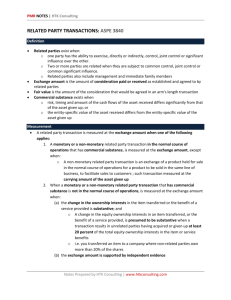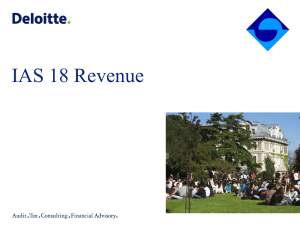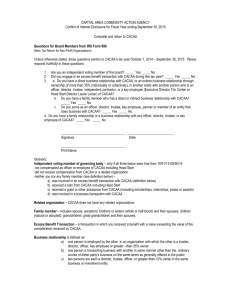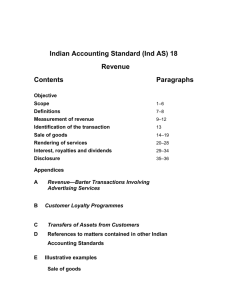revenue: ias 18 - HTK Consulting
advertisement
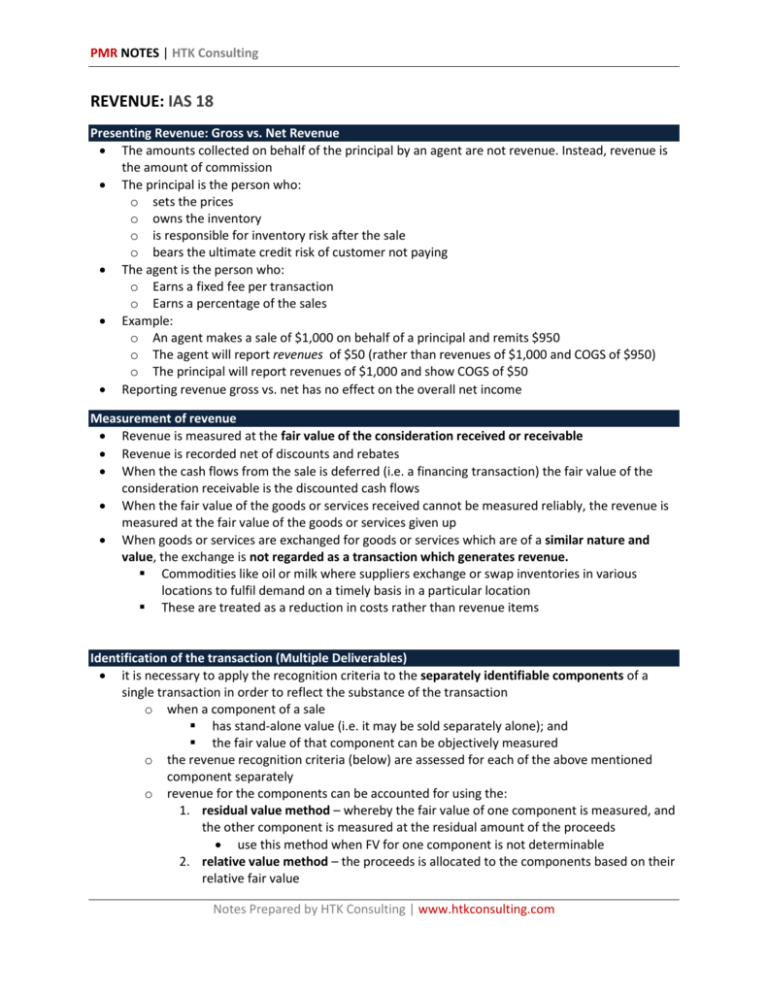
PMR NOTES | HTK Consulting REVENUE: IAS 18 Presenting Revenue: Gross vs. Net Revenue The amounts collected on behalf of the principal by an agent are not revenue. Instead, revenue is the amount of commission The principal is the person who: o sets the prices o owns the inventory o is responsible for inventory risk after the sale o bears the ultimate credit risk of customer not paying The agent is the person who: o Earns a fixed fee per transaction o Earns a percentage of the sales Example: o An agent makes a sale of $1,000 on behalf of a principal and remits $950 o The agent will report revenues of $50 (rather than revenues of $1,000 and COGS of $950) o The principal will report revenues of $1,000 and show COGS of $50 Reporting revenue gross vs. net has no effect on the overall net income Measurement of revenue Revenue is measured at the fair value of the consideration received or receivable Revenue is recorded net of discounts and rebates When the cash flows from the sale is deferred (i.e. a financing transaction) the fair value of the consideration receivable is the discounted cash flows When the fair value of the goods or services received cannot be measured reliably, the revenue is measured at the fair value of the goods or services given up When goods or services are exchanged for goods or services which are of a similar nature and value, the exchange is not regarded as a transaction which generates revenue. Commodities like oil or milk where suppliers exchange or swap inventories in various locations to fulfil demand on a timely basis in a particular location These are treated as a reduction in costs rather than revenue items Identification of the transaction (Multiple Deliverables) it is necessary to apply the recognition criteria to the separately identifiable components of a single transaction in order to reflect the substance of the transaction o when a component of a sale has stand-alone value (i.e. it may be sold separately alone); and the fair value of that component can be objectively measured o the revenue recognition criteria (below) are assessed for each of the above mentioned component separately o revenue for the components can be accounted for using the: 1. residual value method – whereby the fair value of one component is measured, and the other component is measured at the residual amount of the proceeds use this method when FV for one component is not determinable 2. relative value method – the proceeds is allocated to the components based on their relative fair value Notes Prepared by HTK Consulting | www.htkconsulting.com PMR NOTES | HTK Consulting o use this method when FV for all components are determinable Example: A fitness club sells a $1,000 annual gym membership. In addition to annual usage of the gym, the $1,000 also entitles the user 10 hours with a fitness trainer. Stand-alone value ; The monthly usage and the fitness trainer time both have stand-alone value because a person can buy it separately Fair Value; can be objectively because, they are also separately sold $1,000 will be allocated to the components using either the relative value or the residual value method The rev rec criteria will be assessed separately for the annual membership and the fitness trainer time The annual membership will be recognized on a straight line basis over monthly The fitness trainer time will be recognized as the trainer spends the time with the user Revenue Recognition Sale of Goods (remember acronym RIMEM) Revenue from the sale of goods is recognised when all the following conditions are met: 1. the entity has transferred significant risks and rewards of ownership of the goods to the buyer; 2. the entity retains neither continuing managerial involvement to the degree usually associated with ownership nor effective control over the goods sold; 3. the amount of revenue can be measured reliably; 4. it is probable that the economic benefits associated with the transaction will flow to the entity; and 5. the costs incurred or to be incurred in respect of the transaction can be measured reliably Significant Risks o In most cases, the transfer of the risks and rewards of ownership coincides with the transfer of the legal title or the passing of possession to the buyer o Examples of situations in which the entity has not transferred risks and rewards of ownership are: when the entity retains an obligation for unsatisfactory performance not covered by normal warranty provisions; when the receipt of the revenue from a particular sale is contingent on whether the buyer sells the goods (consignment arrangements); when the goods are shipped subject to installation and the installation is a significant part of the contract which has not yet been completed by the entity; and when the buyer has the right to return the good and the entity is uncertain about the probability of return. o When refunds are offered, as long as the future returns can be reasonably estimated based on past track record or other relevant factors, a revenue can be recognized (net of the provision for the return) Probable Future Economic Benefits o If uncertainties exist about the collectability of the amounts due from a sale, this criteria may not be met (unless you can reliably measure the amount that is uncollectable) Notes Prepared by HTK Consulting | www.htkconsulting.com PMR NOTES | HTK Consulting Rendering of services (remember acronym MPSC) revenue associated with the transaction is recognised by reference to the stage of completion of the transaction (percentage of completion method) at the end of the reporting period when all the following are met: 1. 2. 3. 4. the amount of revenue can be measured reliably; it is probable that the economic benefits from the transaction will flow to the entity; the stage of completion of the transaction can be measured reliably; and the costs incurred for the transaction and the costs to complete the transaction can be measured reliably If any of the 4 criteria above are not met , revenue shall be recognised only to the extent of the expenses recognised that are recoverable (revenues = expenses, we call this the cost recovery method) Completed contract method is not allowed under IFRS Different ways to come up with “stage of completion” surveys of work performed; services performed to date as a percentage of total services to be performed; or the proportion that costs incurred to date relative to the estimated total costs of the transaction When a specific act is much more significant than any other acts, the recognition of revenue is postponed until the significant act is executed When several acts are performed over time, and when no single act is more significant than the other, revenue is recognized on a straight line basis Interest, royalties and dividends Revenue arising from the use by others of entity assets yielding interest, royalties and dividends shall be recognised when: o it is probable that the economic benefits from the transaction will flow to the entity; and o the amount of the revenue can be measured reliably. Revenue shall be recognised on the following bases: o interest shall be recognised using the effective interest method o royalties shall be recognised on an accrual basis o dividends shall be recognised when the shareholder's right to receive payment is established Comparison to ASPE under ASPE, the revenue recognition criteria are slightly different under ASPE, the completed contract method is allowed Notes Prepared by HTK Consulting | www.htkconsulting.com




